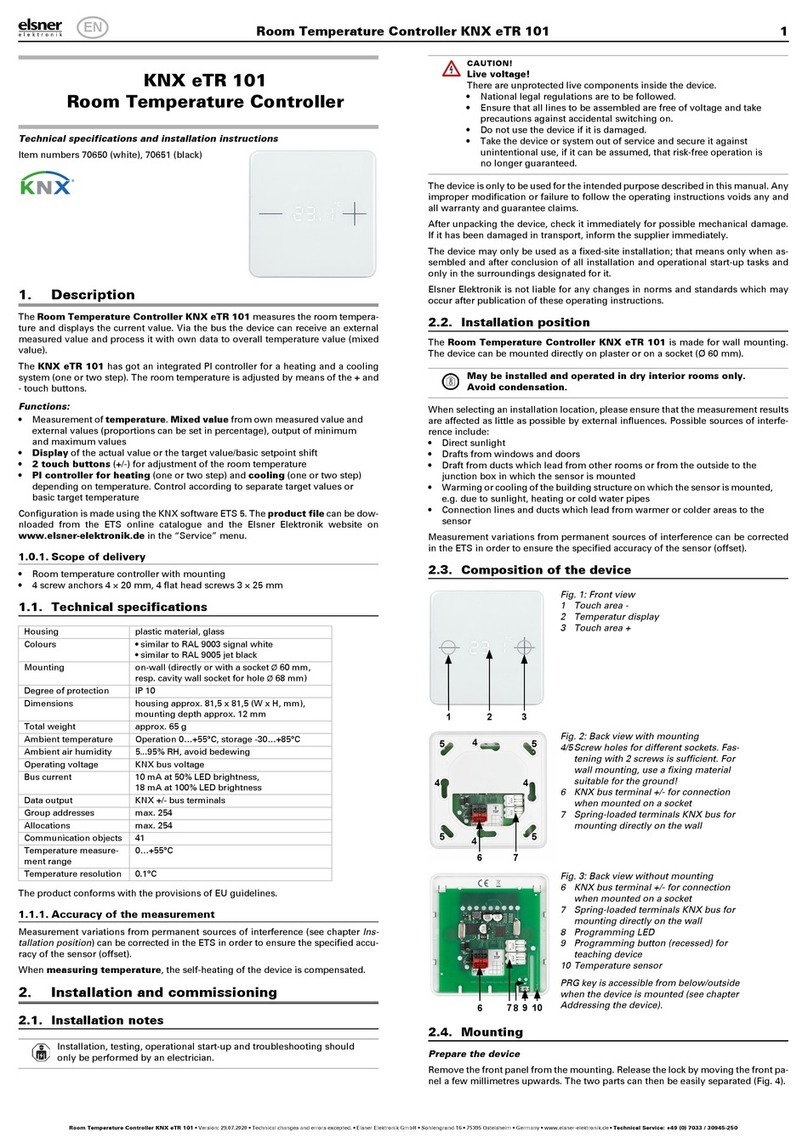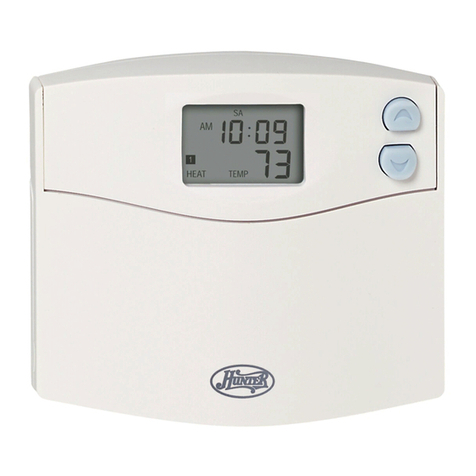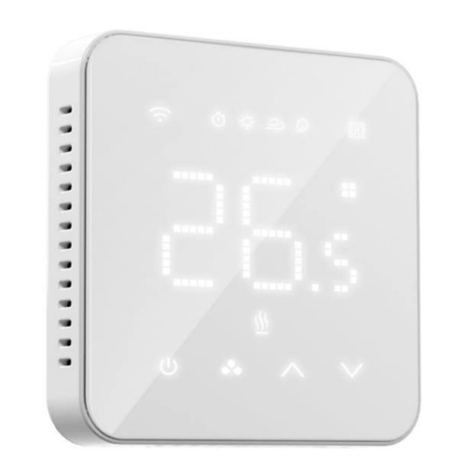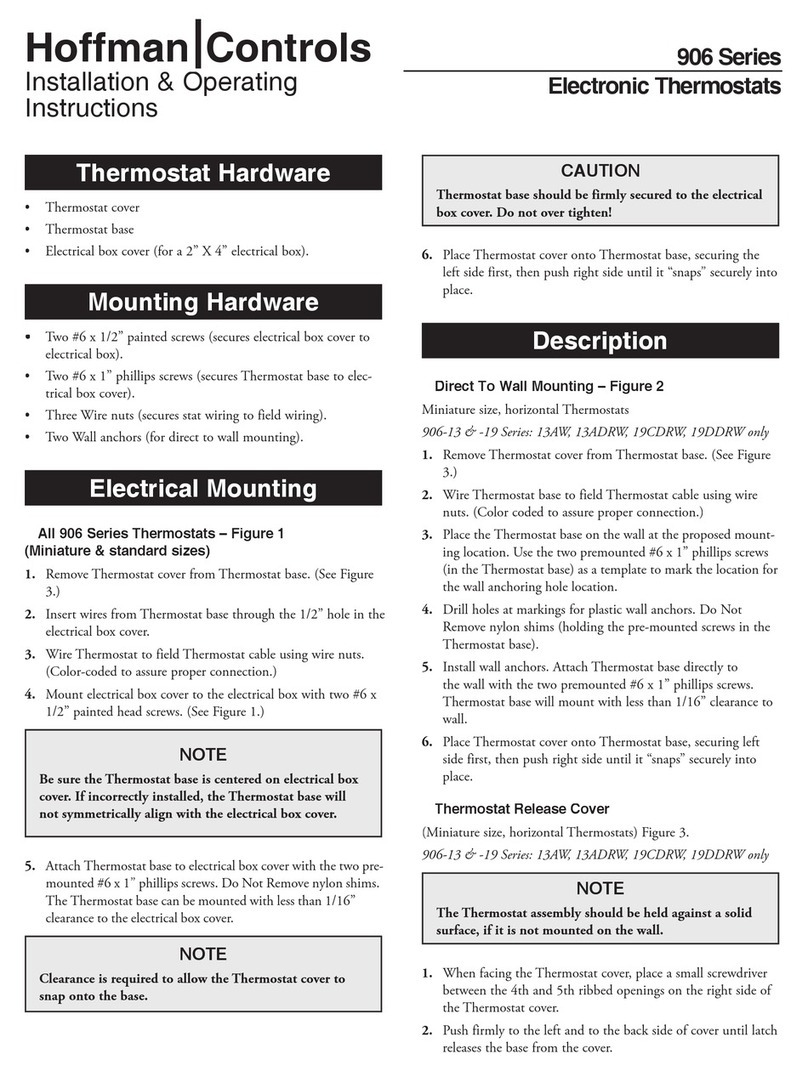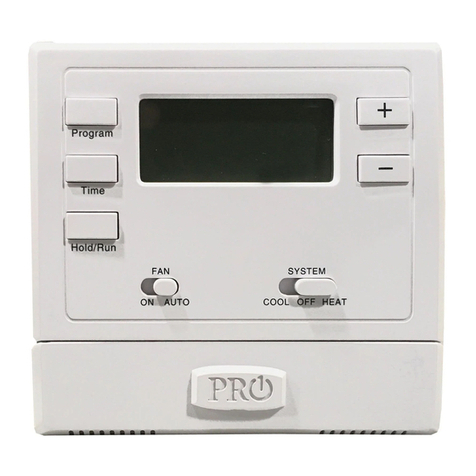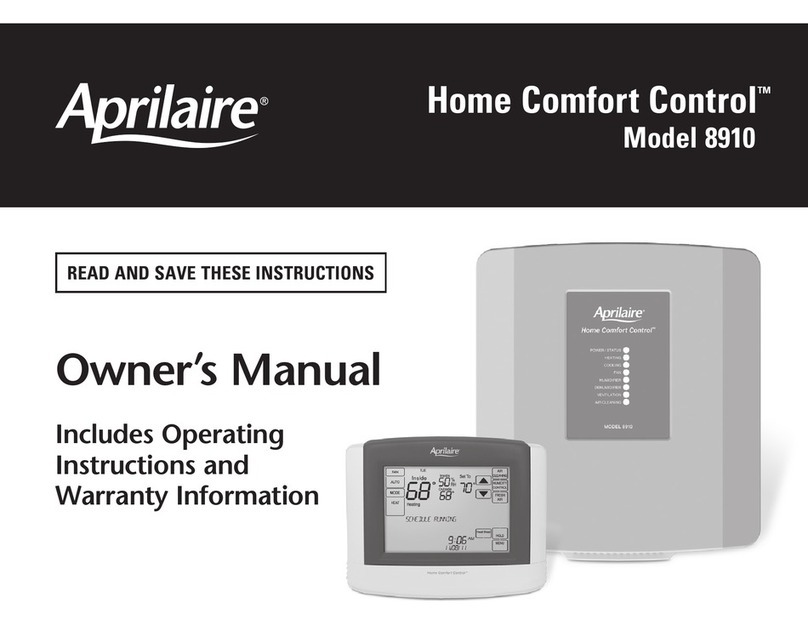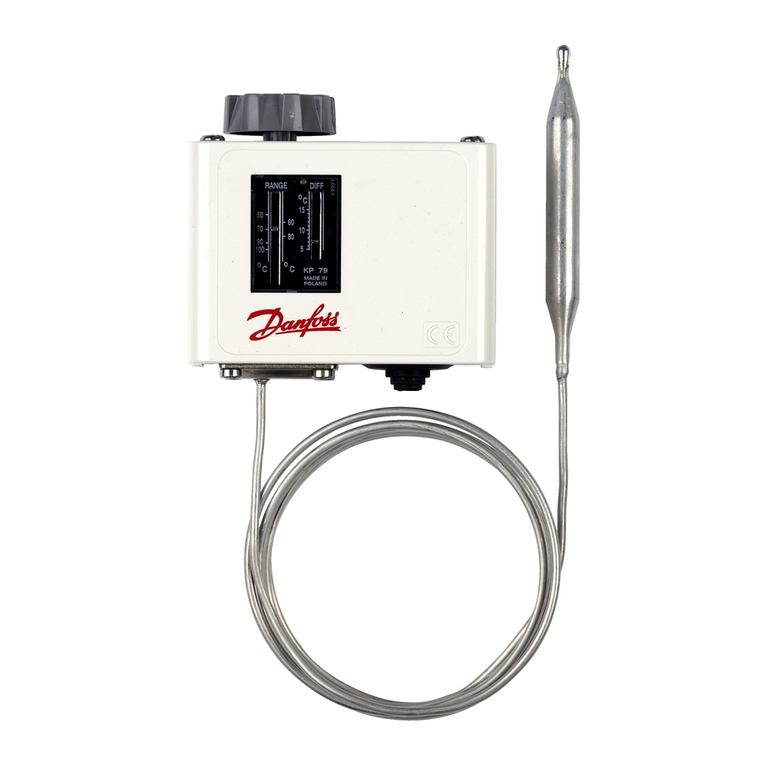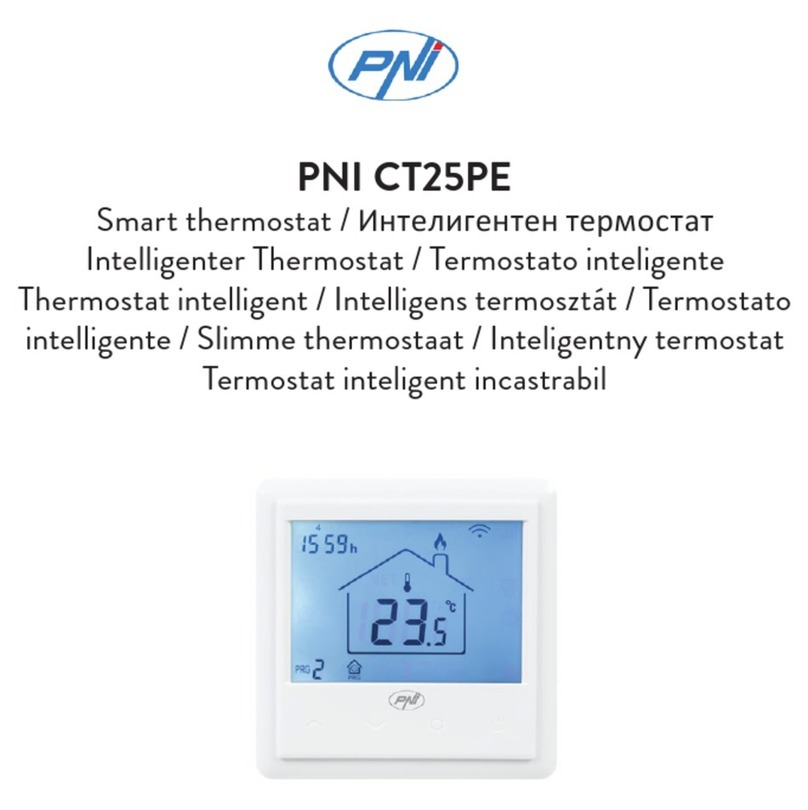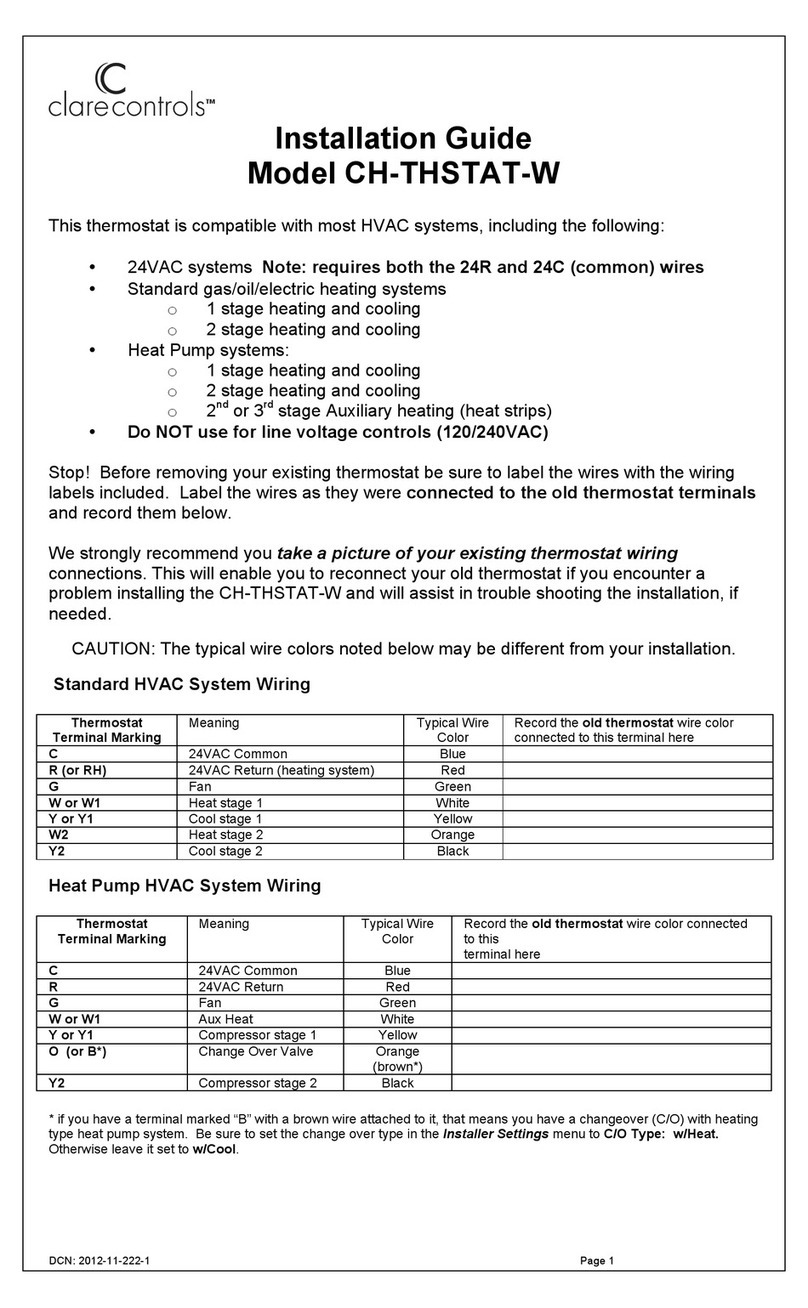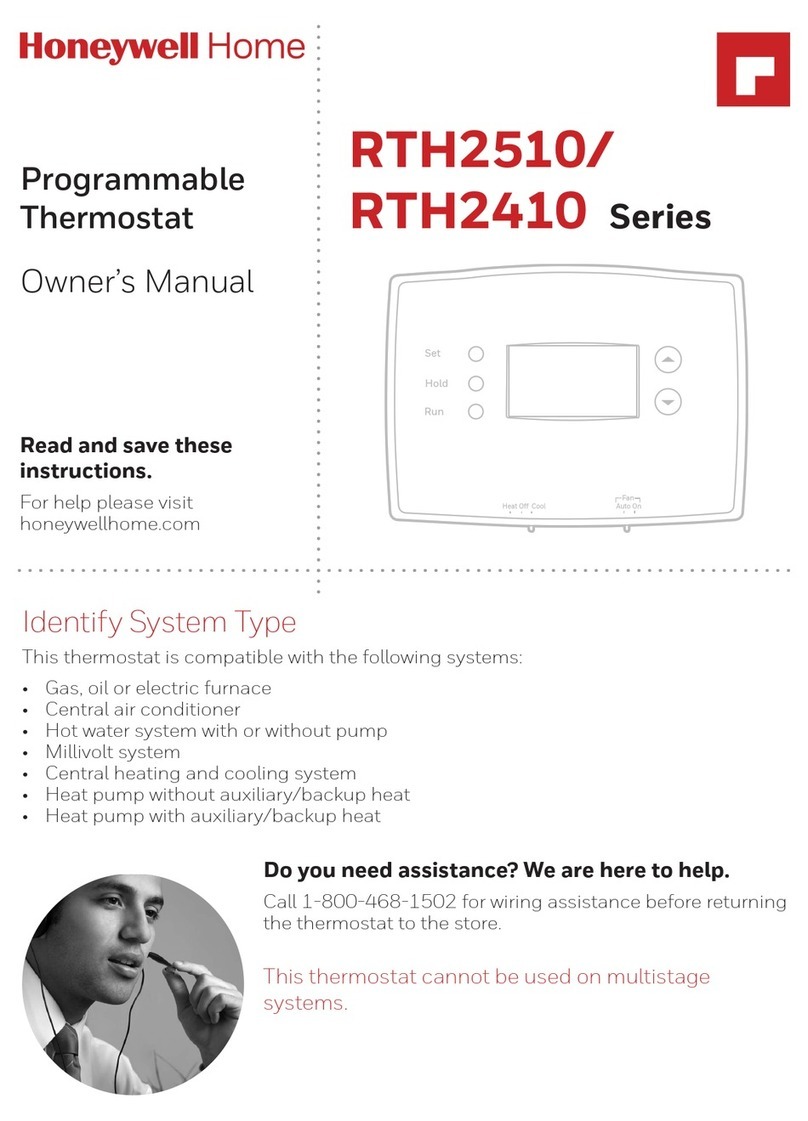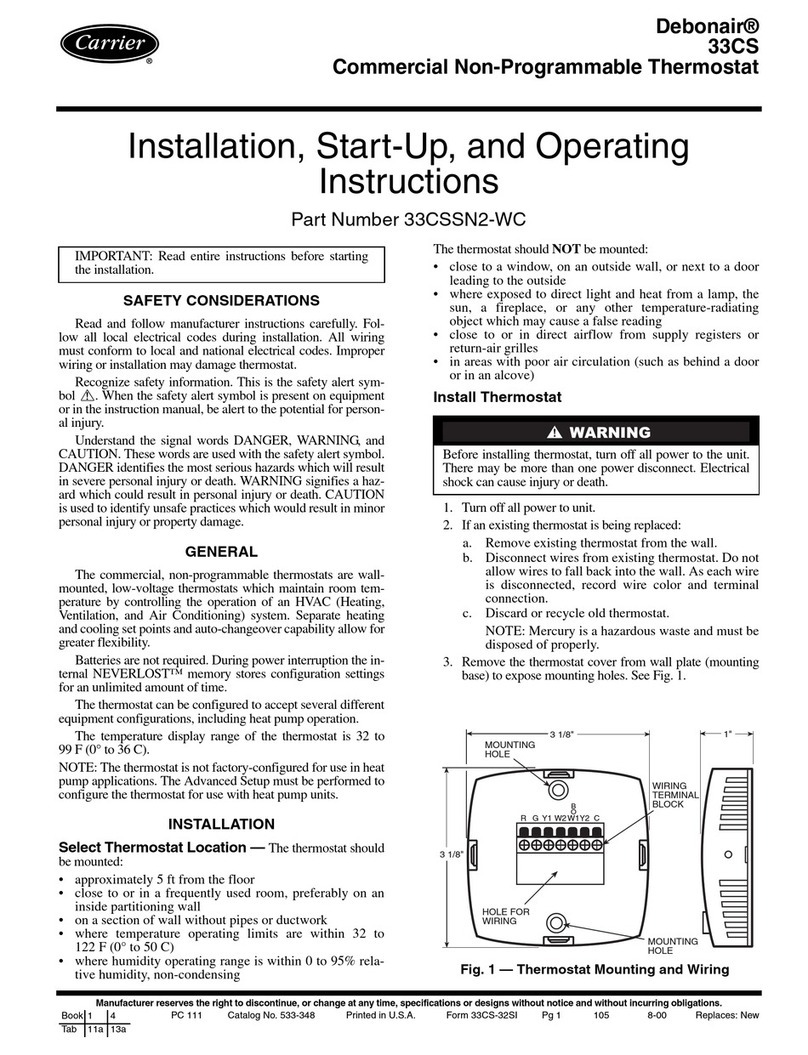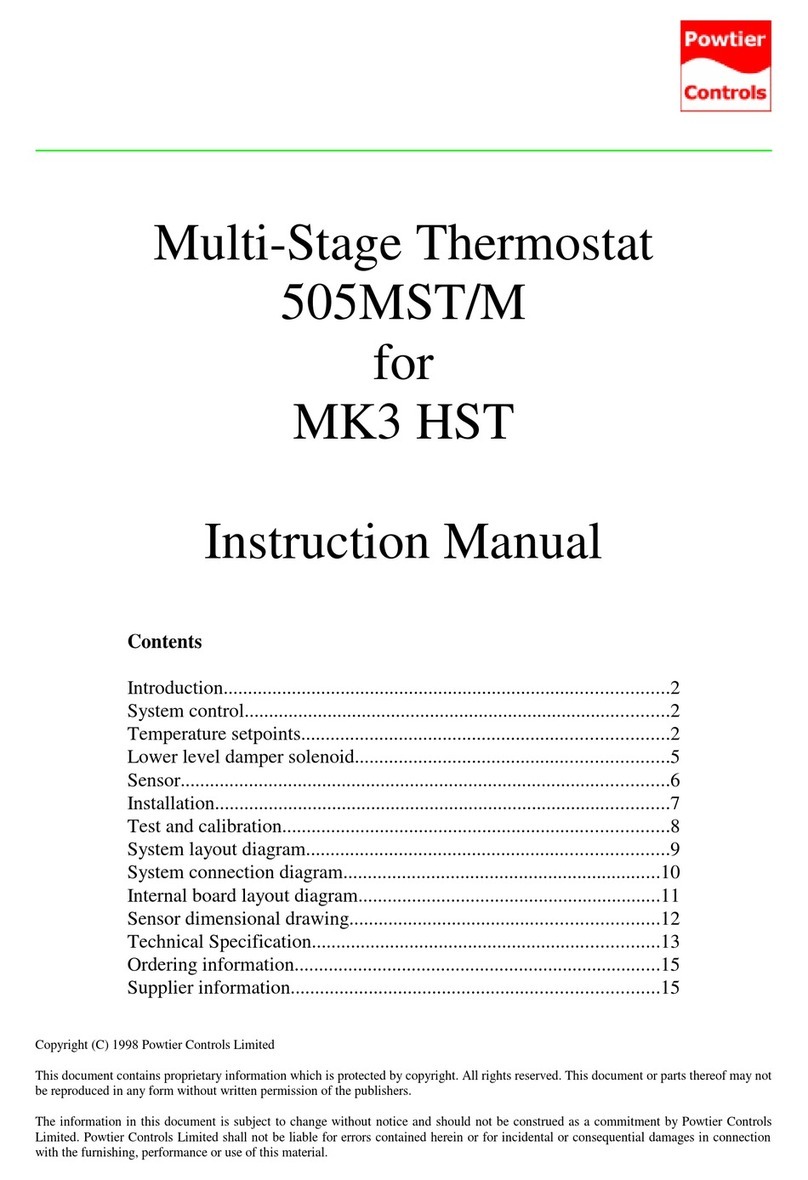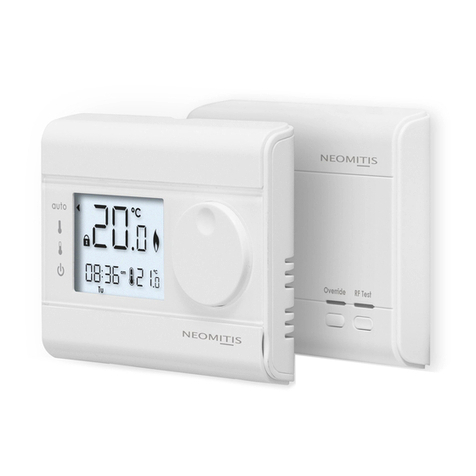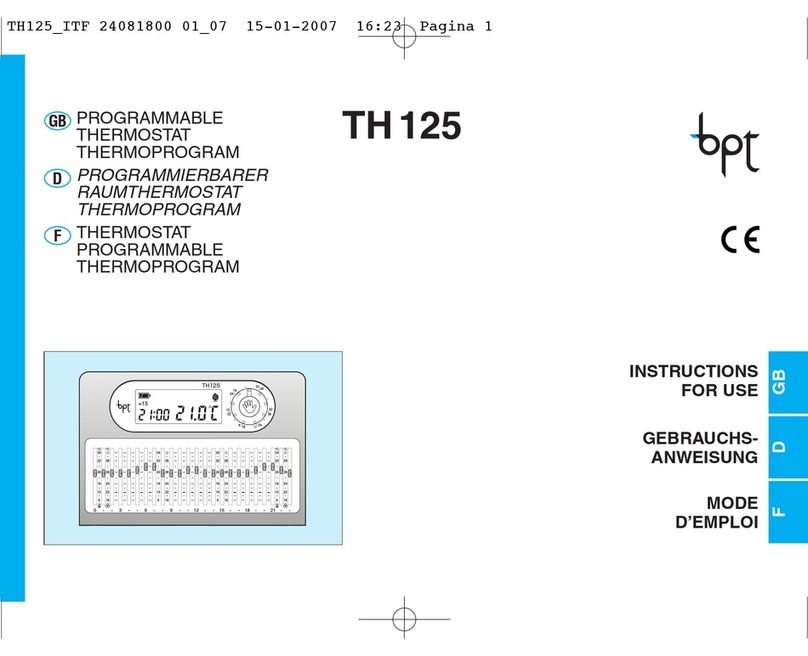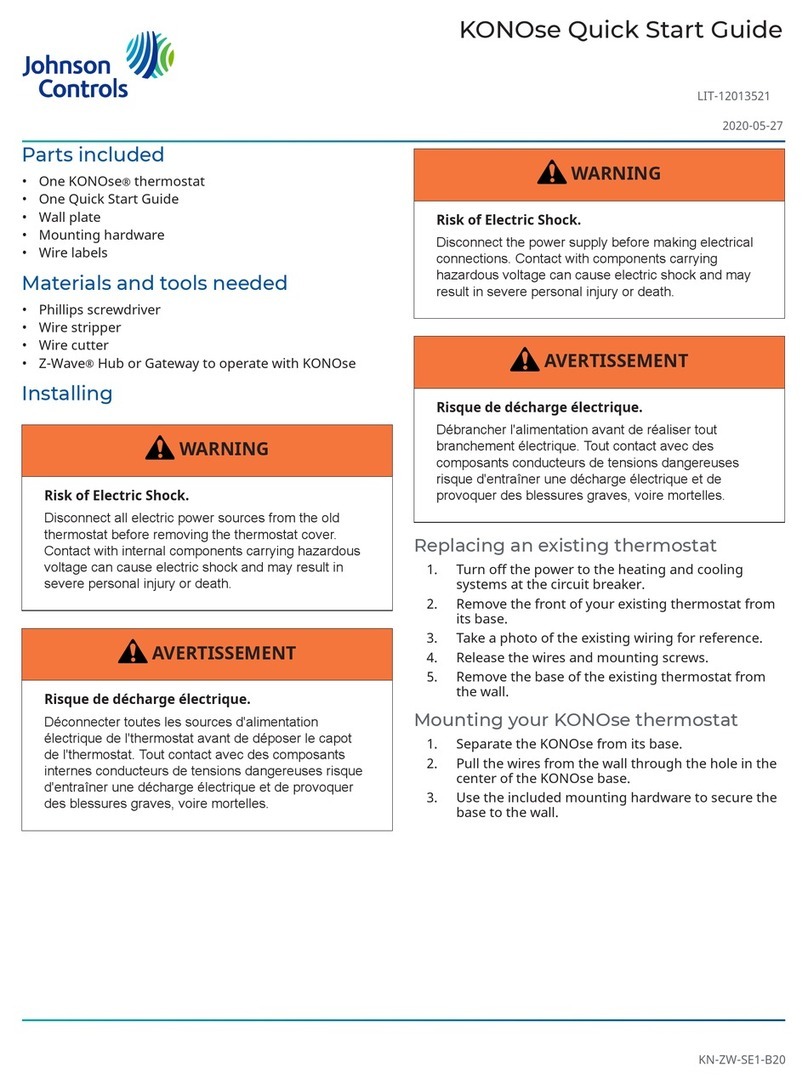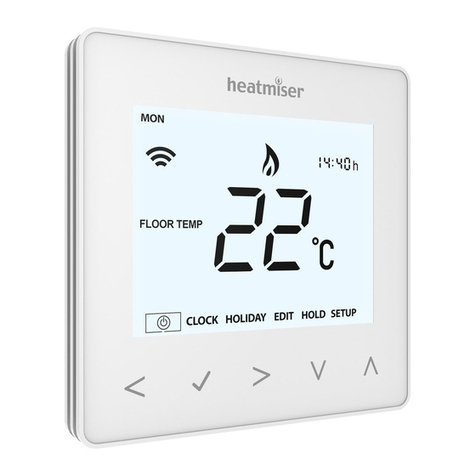Elsner Cala Touch KNX CH Series User manual

Room Controller Cala Touch KNX CH 1
Room Controller Cala Touch KNX CH • Version: 28.04.2020 • Technical changes and errors excepted. • Elsner Elektronik GmbH • Sohlengrund 16 • 75395 Ostelsheim • Germany • www.elsner-elektronik.de • Technical Service: +49 (0) 7033 / 30945-250
EN
Technical specifications and installation instructions
This document describes the functions for ALL device models.
Please check the information at the beginning of the chapter and in the
text which describes the functions available for the respective
individual models.
1. Description
The Room Controller Cala Touch KNX CH for the KNX bus system measures va-
rious ambient climate. Via the bus, the indoor sensor can receive external values
and process them further with its own data to a total value (mixed value, e.g. room
average).
All measured values can be used for the control of threshold value-dependent swit-
ching outputs. States can be linked via AND logic gates and OR logic gates. Multi-
functional modules change input data as required by means of calculations, query-
ing a condition, or converting the data point type. In addition, an integrated mani-
pulated variable comparator can compare and output variables that were received
via communication objects.
Integrated PI-controllers control ventilation (according to humidity or CO2-concen-
tration) and/or heating/cooling (according to temperature), depending on the re-
spective model.
Cala Touch KNX CH features a touch display that shows various display and con-
trol pages depending on the individual configuration. There is one page available
that shows the current measured values, a menu area to adjust device settings and
pages with touch control elements for internal temperature control, for light (manu-
al switching or dimming), for shades or windows (manual operation).
Cala Touch KNX CH is supplemented with a frame of the switch series used in
buildings, and thus fits seamlessly into the interior fittings.
Common features in all models:
•Colour touch display with display and operating pages for
- 1× display of current measured values
- 1× display of bus data (4 universal spaces)
- 1× temperature control (incl. mode change, indication whether heating/
cooling active); can also be used as an extension unit for operating another
controller
- 3× drive operation (shading, window) with buttons, slider, position display
(incl. slat position)
- 3× switching or dimming of light (with percentage display)
- 1× RGB light control
- 1× light color temperature setting
- 1× HCL control (adaption of light color temperature over adjustable periods
of time)
- 1× scenes (4 scenes with recall, storage, status indication)
- weekly timer switch with 8 periods
- 2× info page (each displays 2 text objects)
- device settings
•Screen saver (clock, clock/indoor/outdoor temperature alternately, off) may
be switched on or off
• Key tone may be switched on or off
•4 inputs for binary contacts or T-NTC temperature sensor.
•8 AND and 8 OR logic gates each with 4 inputs. All switching events as
well as 16 logic inputs (in the form of communications objects) can be used
as inputs for the logic gates. The output from each gate can be configured
optionally as 1-bit or 2 x 8-bit
•8 multi-function modules (computers) for changing the input data by
calculations, by querying a condition or by converting the data point type
•4 manipulated variable comparators to output minimum, maximum or
average values. 5 inputs each for values received via communication objects
•Summer compensation for cooling systems. A characteristic curve
matches the target temperature in the room to the external temperature and
sets the minimum and maximum target temperature values
Cala Touch KNX AQS/TH functions (no. 70821, 70823):
• Measuring the CO2-concentration of the air, the temperature and air
humidity (relative, absolute), each with mixed value calculation. The
share of internal measurement value and external value can be set as a
percentage
• Bus message, whether the values for temperature and air humidity are within
the comfort field (DIN 1946). Dew point calculation
•Threshold values can be adjusted per parameter or via communication
objects
•PI-controller for heating (one or two-level) and cooling (one or two-level)
according to temperature. Regulation according to separate set points or
basic set point temperature. Fan coil control
•PI controller for ventilation according to humidity and CO2-concentration:
Ventilate/Air (one-level) or Ventilate (one or two-levels)
Cala Touch KNX TH functions (no. 70811, 70813):
•Temperature and air humidity measurement (relative, absolute), in each
case with mixed value calculation. The share of internal measurement
value and external value can be set as a percentage
• Bus message, whether the values for temperature and air humidity are within
the comfort field (DIN 1946). Dew point calculation
•Threshold values can be adjusted per parameter or via communication
objects
•PI-controller for heating (one or two-level) and cooling (one or two-level)
according to temperature. Regulation according to separate setpoints or
basic set point temperature. Fan coil control
•PI controller for ventilation according to humidity: Ventilate/Air (one-
level) or Ventilate (one or two-level)
Cala Touch KNX T functions (no. 70801, 70803):
• Measuring the Temperature with a mixed value calculation. The share of
internal measurement value and external value can be set as a percentage
•Threshold values can be adjusted per parameter or via communication
objects
•PI-controller for heating (one or two-level) and cooling (one or two-level)
according to temperature. Regulation according to separate set points or
basic set point temperature. Fan coil control
Configuration is made using the KNX software ETS. The product file can be dow-
nloaded from the Elsner Elektronik website on www.elsner-elektronik.de in the
“Service” menu.
1.0.1. Deliverables
• Housing with display
• Mounting adapter with screws
• Analogue/digital supply line
You will need in addition (not supplied):
•Inletbox
• Cover frame (for insert 60 x 60 mm) and mounting plate (77 mm) for swiss
installation standard
1.1. Technical specifications
Cala Touch KNX CH
Room Controller
Item numbers
Cala Touch KNX T CH:
70801 (pure white RAL 9010),
70803 (jet black RAL 9005)
Cala Touch KNX TH CH:
70811 (pure white RAL 9010),
70813 (jet black RAL 9005)
Cala Touch KNX AQS/TH CH:
70821 (pure white RAL 9010),
70823 (jet black RAL 9005)
Material Real glass, plastic
Display Visible diagonal: 2.3 inch (59 mm)
Resolution: 320 × 240 pixel
Colours • white glass, white housing (pure white RAL
9010)
• black glass, black housing (jet black RAL
9005)
Assembly Installation in inlet box
Protection category IP 20
Dimensions approx. 60 × 60 (W × H × D, mm), mounting
depth approx. 8 mm
Total weight approx. 70 g (including mounting adapter)
Ambient temperature Operation -20…+70°C, storage -30…+70°C
Ambient humidity max. 95% RH, avoid condensation
Operating voltage KNX bus voltage
Bus current max. 18 mA
Data output KNX +/- bus connector terminal
BCU type Integrated microcontroller
PEI type 0
Group addresses max. 2000
Assignments max. 2000
Communication objects Cala Touch KNX AQS/TH: 471
Cala Touch KNX TH: 433
Cala Touch KNX T: 379
Inputs 4× analogue/ digital, max. cable length 10 m.
measuring range T-NTC
temperature sensor on
Cala input
-40°C...+80°C
CO2-sensor (for Cala Touch KNX AQS/TH):
CO2-measuring range 300...5000 ppm
CO2resolution 1 ppm
Temperature sensor (for Cala Touch KNX AQS/TH, Cala Touch KNX TH,
Cala Touch KNX T):
Temperature measu-
ring range
-20…+70°C
Temperature resolution 0.1°C
Humidity sensor (for Cala Touch KNX AQS/TH, Cala Touch KNX TH):
Humidity measuring
range
0% HR … 100% HR
Humidity resolution 0.1%
Humidity drift ± 0.5% RH per year in normal atmosphere

Room Controller Cala Touch KNX CH 2
Room Controller Cala Touch KNX CH • Version: 28.04.2020 • Technical changes and errors excepted. • Elsner Elektronik GmbH • Sohlengrund 16 • 75395 Ostelsheim • Germany • www.elsner-elektronik.de • Technical Service: +49 (0) 7033 / 30945-250
The product is compliant with the provisions of EC guidelines.
1.1.1. Measuring accuracy
Measurement deviations due to sources of interference (see chapter Installation lo-
cation) must be corrected in the ETS in order to ensure the specified accuracy of the
sensor (offset).
For a correct CO2measurement it is necessary to install the device in a windproof
socket. After applying the operating voltage, it can take up to 15 minutes until the
CO2measured value is output correctly.
During temperature measurement, the self-heating of the device is taken into
consideration by the electronics. It is compensated for by the software, therefore the
displayed/output inside temperature measuring value is correct.
2. Installation and commissioning
2.1. Installation notes
Installation, testing, operational start-up and troubleshooting should
only be performed by an electrician.
CAUTION!
Live voltage!
There are unprotected live components inside the device.
• National legal regulations are to be followed.
• Ensure that all lines to be assembled are free of voltage and take
precautions against accidental switching on.
• Do not use the device if it is damaged.
• Take the device or system out of service and secure it against
unintentional use, if it can be assumed, that risk-free operation is
no longer guaranteed.
The device is only to be used for its intended purpose. Any improper modification
or failure to follow the operating instructions voids any and all warranty and gua-
rantee claims.
After unpacking the device, check it immediately for possible mechanical damage.
If it has been damaged in transport, inform the supplier immediately.
The device may only be used as a fixed-site installation; that means only when as-
sembled and after conclusion of all installation and operational start-up tasks and
only in the surroundings designated for it.
Elsner Elektronik is not liable for any changes in norms and standards which may
occur after publication of these operating instructions.
2.2. Installation location
The sensor is made for wall mounting in an inlet box. The device is supplemented
with a frame of the 60 mm swiss installation standard..
The sensor may only be installed and used in dry interior
spaces. Avoid condensation.
When selecting an installation location, please ensure that the measurement results
are affected as little as possible by external influences. Possible sources of interfe-
rence include:
• Direct sunlight
• Draughts from windows and doors
• Draughts from ducts which lead to the junction box in which the sensor is
mounted from other rooms.
• Warming or cooling of the building structure on which the sensor is mounted,
e.g. due to sunlight, heating or cold water pipes
• Connection lines, which lead from warmer or colder areas to the sensor
Temperature variations from such sources of interference must be corrected in the
ETS in order to ensure the specified accuracy of the sensor (temperature offset).
2.3. Device design
Analogue/digital supply line inputs:
2.4. Sensor assembly
First of all fit the windproof inlet box with connection. Also seal inlet pipes to avoid
infiltration.
Turn the screws little way into the mounting adapter.
Position the frame of the switching programme. Connect the bus line +/- to the
black-red plug.
Pin the housing with the notches on to the mounting adapter, so that device and
frame are fixed.
2.5. Notes on mounting and commissioning
Never expose the device to water (e.g. rain) or dust. This can damage the electro-
nics. You must not exceed a relative humidity of 95%. Avoid condensation.
After the bus voltage has been applied, the device will enter an initialisation phase
lasting a few seconds. During this phase no information can be received or sent via
the bus.After the bus voltage has been applied, the device will enter an initialisation
phase lasting a few seconds. During this phase no information can be received or
sent via the bus.
3. Addressing the equipment
The equipment is delivered with the bus address 15.15.255. You can program a dif-
ferent address in the ETS by overwriting the address 15.15.255 or by teaching the
device via the programming button.
The programming button can be reached through the opening on the rear of the
housing; it is recessed. Use a thin object to reach the button, e.g. a 1.5 mm² wire.
4. Maintenance and care
Fingerprints on the display and the housing are best removed with a cloth moiste-
ned with water or a microfibre cloth. Do not use an abrasive cleaning agent or ag-
gressive cleansing agents.
1yellow (GND) –– Input 1
2yellow ––
3white (GND) –– Input 2
4white ––
1
2
4
Fig. 1
1 Mounting adapter with screws
2 Openings for air circulation
3 Catches
4 Touch Display
5KNX-terminalBUS+/-
6 Slot for connecting cable
7 Programming-LED (recessed)
8 Programming-Button (reces-
sed) for teaching device
7
3
5
8
6
3
5orange (GND) –– Input 3
6brown ––
7purple (GND) –– Input 4
8blue ––
Fig. 2
Hook the mounting adapter into
the mounting plate of the
switch system and tighten the
screws.
Fig. 3
Screw the mounting plate onto
the inlet box
This manual suits for next models
9
Other Elsner Thermostat manuals
